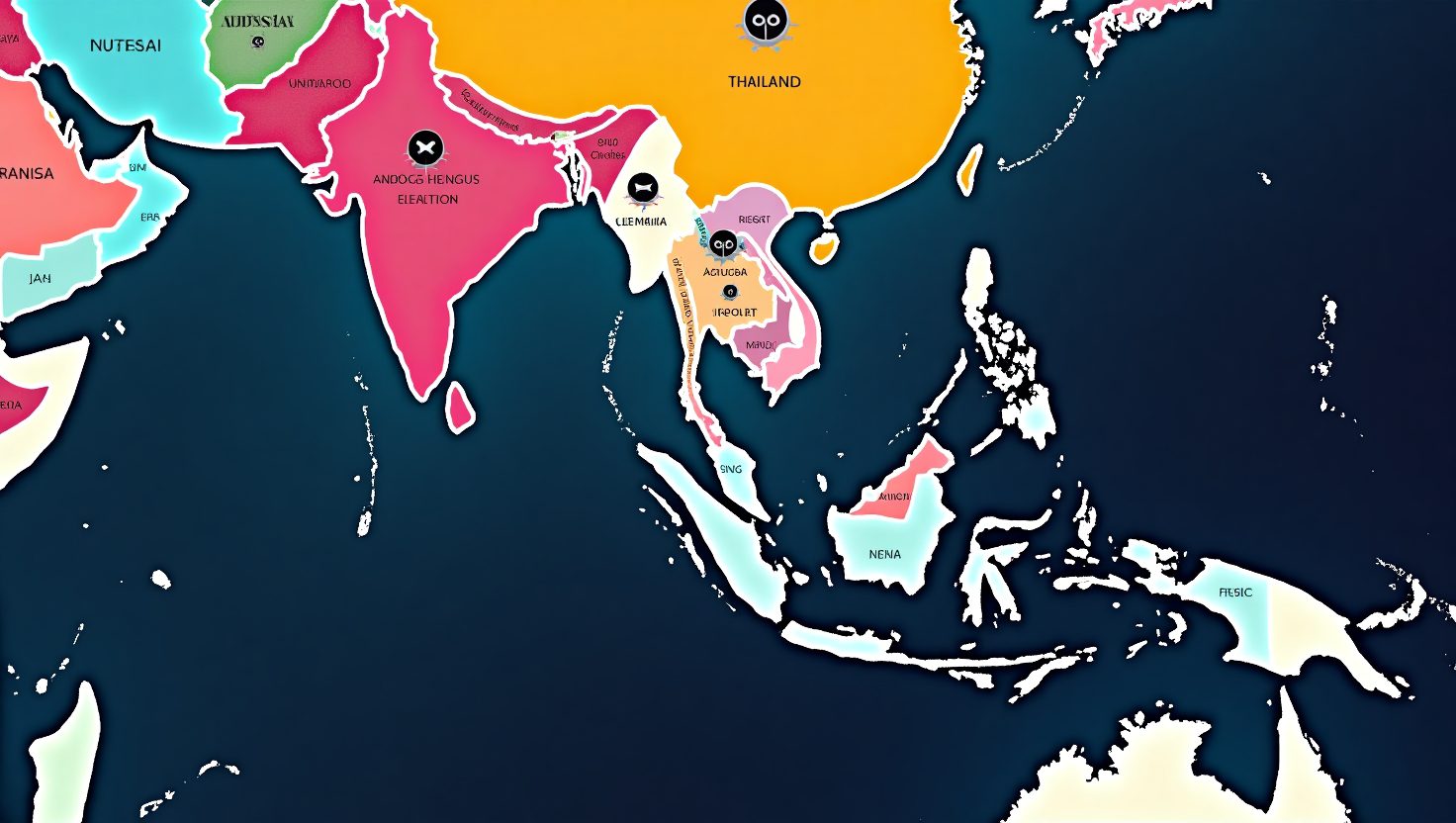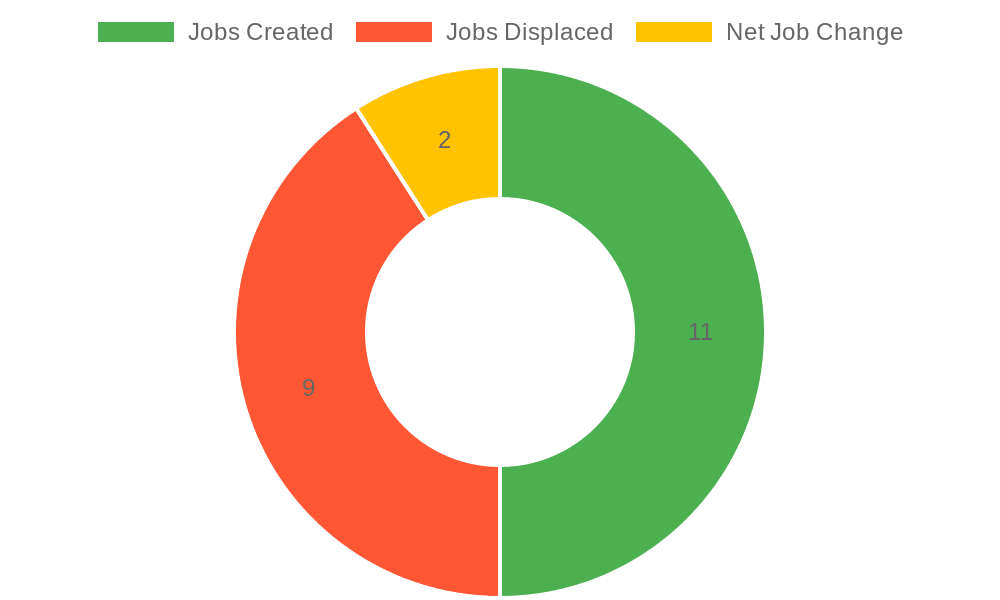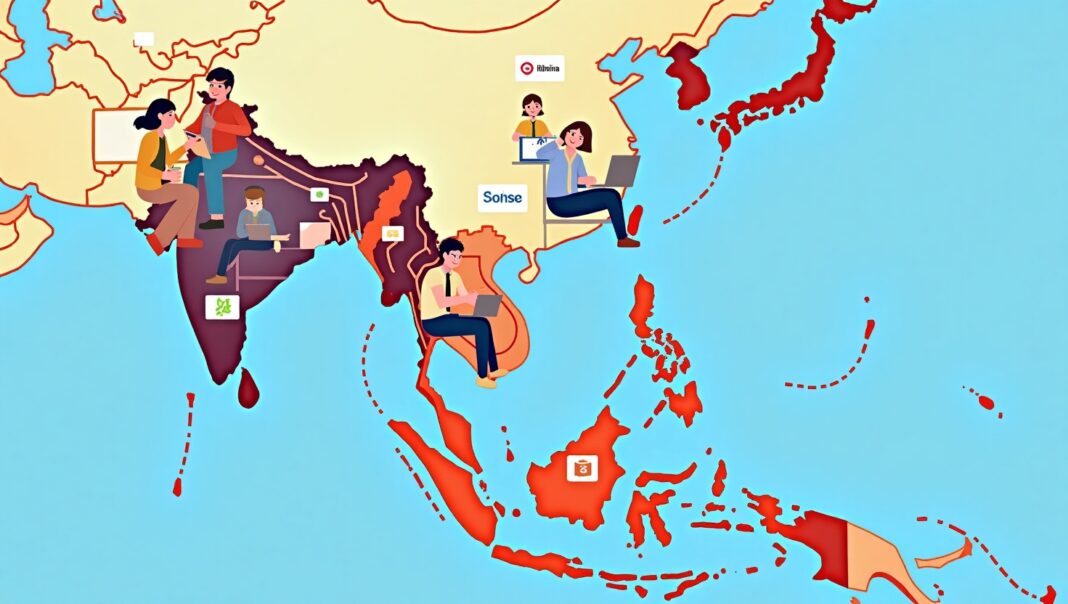In an era defined by rapid technological advancement, Agentic AI stands as a transformative force that is reshaping the economic landscape in Southeast Asia. This multifaceted technology, capable of making decisions, acting autonomously, and continually refining its strategies, brings forth a dual-edged impact: the potential to generate 11 million new jobs by 2030 while simultaneously displacing nine million.
Key Points:
- Urgent need for effective reskilling strategies to equip the workforce for a new digital reality.
- Studies predict that up to 57% of job roles may see augmentation or disruption.
- Balancing economic growth—estimated at unlocking as much as US$450 billion by 2028—with ethical complexities of AI.
As we navigate this era of uncertainty, it becomes essential to foster an environment where innovation and human ingenuity coexist, ensuring that the rise of Agentic AI benefits society as a whole.


The landscape of employment in Southeast Asia is set for a significant transformation driven by Agentic AI technology. By the year 2030, it is projected that approximately 11 million new jobs will be created due to the implementation of AI systems, while simultaneously, 9 million jobs may be displaced. This means there will be a net increase of around 2 million jobs, indicating a promising yet challenging future for the workforce in the region.
Key Insights on Job Creation and Displacement:
- Indonesia: The country anticipates a displacement of around 2 million jobs, particularly in sectors such as agriculture, wholesale and retail, and manufacturing. However, job creation is expected to rise in sectors like wholesale and retail (with an anticipated 2.3 million new jobs), agriculture (1.8 million), and manufacturing (1.4 million). 59% of jobs in Indonesia may experience augmentation or disruption, emphasizing the need for skills development and reskilling initiatives.
- Broader Economic Impact: Across the ASEAN economies, job displacement and creation varied, with significant job losses expected in agriculture and traditional sectors. Despite this, AI technologies are projected to unlock up to USD 450 billion in economic value by 2028, contributing 10 to 18 percent to regional GDP by 2030. This substantial economic uplift is vital as it reflects the ability of AI to enhance productivity and efficiency across industries.
Role of Augmentation in Indonesia:
In Indonesia, AI’s augmentative effect on job roles is particularly noteworthy. It allows existing employees in sectors like data analysis to shift focus towards critical thinking and strategic roles by automating routine tasks. Furthermore, demographic disparities reveal that a higher percentage of women and Gen Z workers are employed in roles susceptible to AI disruption, necessitating targeted reskilling programs to better prepare these groups for future employment landscapes.
Conclusion
The dual impact of Agentic AI—creating job opportunities while also leading to job displacement—underscores the need for strategic governance and planning. To harness the potential economic value and mitigate disruption, Southeast Asian nations must prioritize reskilling initiatives, fostering an adaptable workforce ready for the challenges and opportunities that AI presents.
Economic Value of Agentic AI
The emergence of Agentic AI is set to unlock significant economic potential, with projections estimating an infusion of up to USD 450 billion into the economies of Southeast Asia by 2028. This substantial figure indicates a major change in the region’s economic landscape, fueled by the transformative capabilities of Agentic AI. These capabilities can enhance operational efficiency, lower costs, and foster innovation across various industries.
In Southeast Asia, where many nations aim to modernize their economies and integrate advanced technologies, realizing this economic value is crucial. The expected USD 450 billion is not just a target but a pathway that could redefine industry standards, improve global competitiveness, and create jobs on an unprecedented scale. Industries such as manufacturing, logistics, agriculture, and services are anticipated to benefit greatly from Agentic AI. This technology will automate complex tasks, streamline operations, and leverage big data analytics for faster decision-making.
Innovation will be key as companies adapt to this new environment. Currently, the challenge for many organizations is not just adopting Agentic AI but scaling its use. Recent studies show that only 2% of organizations have successfully scaled their use of Agentic AI, and 14% are in the process of implementation. For Southeast Asian businesses to reap the economic benefits, they must embrace innovation, invest in technological integration, and upskill their workforce to meet new market demands.
The need for reskilling is vital. As companies deploy Agentic AI, workforce transformations will occur—some jobs will change, while others may phase out. Therefore, governments and educational institutions need to collaborate on programs focusing on skills that complement AI technologies, ensuring workers are prepared for the evolving economy.
In summary, the projected economic value of Agentic AI, estimated at USD 450 billion by 2028, signifies a new era for Southeast Asia. By fostering innovation and addressing workforce reskilling needs, the region can leverage this opportunity to boost its economy and establish a sustainable technological future.
| Country | Job Displacement (2028) | Job Creation (2028) | Economic Contribution (GDP Contribution) | Public Perception (%) fearing job loss |
|---|---|---|---|---|
| Indonesia | 2 million | 4.5 million | Up to USD 366 billion | 85% |
| Malaysia | 600,000 | TBD (new digital roles) | Significant growth potential | 73% |
| Thailand | 1.3 million | 2.7 million | TBD (large contributor to GDP) | Not specified |
The Need for Reskilling in Light of Agentic AI Advancements
As advancements in Agentic AI—capable of autonomous decision-making and action—significantly transform job roles across industries, the imperative for workforce reskilling becomes abundantly clear. Industry data indicates a substantial reshaping of employment landscapes due to AI integration, making reskilling crucial for job security and organizational competitiveness.
Impact on Employment and the Need for Reskilling
-
Reduction in Entry-Level Positions: A study from Stanford points to a 13% decrease in entry-level job opportunities in sectors impacted by AI, particularly in software development and customer service. This development has marked one of the fastest workforce transformations observed, echoing the swift transitions seen during the pandemic’s remote work shift.
Source -
Anticipated Workforce Redeployment: Research by Salesforce indicates that Chief Human Resources Officers (CHROs) plan to redeploy approximately 23% of their workforce as they adopt Agentic AI. Furthermore, a striking 81% of HR leaders recognize the need to reskill employees to ensure their competitiveness in a market increasingly influenced by AI agents.
Source
Insights from Industry Experts
-
Greg Shewmaker, CEO of r.Potential, asserts, “The survey indicates that the current generation of leaders will be the last to manage human-only workforces.”
Source -
Sanjeev Vohra, Chief Technology and Innovation Officer at Genpact, emphasizes that “Agentic AI demands more than smart algorithms—it demands smart organizations. Enterprises need to reimagine how their people and processes interact with technology. That starts with deeply reskilling the workforce for a future where AI is embedded in every decision.”
Source
Statistics on AI Adoption and Workforce Perception
-
AI Adoption Growth: CHROs expect a 327% increase in Agentic AI adoption over the next two years, with a projected 30% boost in employee productivity once fully integrated.
Source -
Worker Sentiment: A survey by Udacity of over 2,500 tech workers revealed that 61% believe AI could replace their roles within the next three to five years. Despite this apprehension, 70% reported that AI tools have enhanced their productivity and creativity.
Source
Emerging Roles and Skills
As Agentic AI continues to establish its presence, it is not only automating tasks but also giving rise to new job categories focused on AI system design and management. Emerging roles include AI workflow designers, process architects, prompt engineers, and model architects, all essential for the ethical and effective integration of AI technologies.
Source
In summary, the rapid advancement of Agentic AI is fundamentally altering employment landscapes, making reskilling and upskilling imperative for both individuals and organizations. Without timely interventions to adapt workforce skills, companies risk falling behind in their ability to thrive in this AI-governed marketplace.

An office environment illustrating collaboration between humans and Agentic AI systems, emphasizing the necessity for workforce reskilling.
Case Studies on AI Adoption
Numerous organizations have successfully integrated Agentic AI into their operations, leading to significant improvements while also presenting unique challenges. Here are some illuminating case studies:
1. Microsoft’s Integration of AI Agents
Source: The Official Microsoft Blog
Microsoft integrated AI agents across various operations, driving a remarkable transformation. One customer achieved a 65% deflection rate within six months of implementing an agentic management platform, with projections indicating a rise to 80% by year-end. Additionally, the integration led to a 20% increase in accuracy and a 75% reduction in response latency in service delivery. This underscores the crucial need for continuous reskilling and robust oversight to effectively manage the AI landscape.
2. Pets at Home’s AI-Powered Customer Care
Source: The Microsoft Cloud Blog
Pets at Home implemented AI agents powered by Microsoft Copilot Studio to enhance customer experiences across various touchpoints. The AI agents improved fraud detection by swiftly analyzing large datasets, significantly enhancing investigation speed and accuracy. Furthermore, the personalized solutions provided to over 8 million loyalty program members underscore the importance of reskilling staff to work alongside AI effectively while maintaining data integrity and customer trust through oversight.
3. Microsoft 365 Copilot Deployment
Source: Inside Track Blog
With the deployment of Microsoft 365 Copilot across over 300,000 employees and vendors, productivity soared through the use of AI-powered assistance. Employees utilized tools like Copilot Studio Agent Builder, significantly improving knowledge retrieval and workflow efficiency. This initiative required change management practices that emphasized the need for tailored reskilling campaigns and robust governance to ensure responsible AI application.
Challenges in AI Adoption
Source: Forbes
Common challenges in adopting Agentic AI include integration issues with legacy systems, insufficient testing, privacy concerns, and leadership gaps. There is a critical need for comprehensive reskilling programs that equip employees to work alongside AI systems effectively. Moreover, robust oversight mechanisms are essential to address ethical and operational risks associated with AI deployment.
Addressing Algorithmic Bias and User Trust
Source: BestAI Blog
Microsoft’s AI agents significantly boosted productivity and collaboration but highlighted challenges such as algorithmic bias and user trust. To combat these, the company integrated its Responsible AI Standard across product development, emphasizing fairness, transparency, and accountability. Additionally, AI literacy training and user onboarding facilitated trust and successful transitions to AI-augmented workflows, reinforcing the importance of reskilling and oversight in successful AI adoption.
These case studies represent a fraction of the transformative potential of Agentic AI in various industries. However, they also underscore the vital importance of addressing challenges through reskilling, oversight, and fostering an environment of responsible AI use to navigate the evolving landscape of technology and workforce dynamics.
In conclusion, the rise of Agentic AI presents an unprecedented opportunity and challenge for Southeast Asia. With projections indicating a net gain of two million jobs, the impact of this technology on employment cannot be overlooked. However, the immediate risk of displacing nine million jobs underscores the critical need for robust reskilling initiatives across the region.
Policymakers and organizations must act decisively to cultivate a workforce equipped with the necessary skills to thrive in an AI-driven future. By prioritizing education, training, and strategic governance, we can harness the full economic potential of Agentic AI while ensuring job security and growth for all.
Now is the time for collective action; the future of work in Southeast Asia hinges on our ability to adapt and evolve in the face of technological change. Let us make the commitment to reskill and empower our workforce, turning challenges into opportunities for a sustainable economic future.
Trust and Governance in AI
In the context of Agentic AI, trust and governance are paramount to ensure that the deployment of AI technologies aligns with ethical standards and societal values. As AI systems become increasingly autonomous, organizations face the critical challenge of balancing innovation with the need for oversight and accountability. The implications of failures in this area can range from data breaches and algorithmic biases to the erosion of public trust.
Building Trust in AI
Trust in AI is built through transparency, fairness, and accountability. Organizations must communicate clearly about how their AI systems operate, including data usage, decision-making processes, and the measures in place to mitigate risks. This transparency is essential for gaining the confidence of users and stakeholders, particularly in sectors that handle sensitive information, such as healthcare and finance.
To foster trust, organizations can implement ethical AI frameworks that prioritize fairness and inclusivity. Establishing guidelines for ethical AI development involves involving diverse stakeholders in the AI design process, ensuring that multiple perspectives are considered, and proactively addressing potential biases in training data.
Governance Frameworks for AI Deployment
Effective governance frameworks are crucial in overseeing the responsible use of AI technologies. Organizations can establish independent oversight committees to assess AI projects and their alignment with ethical standards. This governance structure should include industry experts, ethicists, and community representatives, ensuring that multiple viewpoints are integrated into decision-making processes.
Additionally, continuous monitoring and evaluation of AI systems are vital to identify and rectify unintended consequences promptly. Implementing robust audit mechanisms can help organizations track AI performance, assess compliance with established ethical standards, and make necessary adjustments to improve their operations and mitigate risks.
Balancing Innovation and Oversight
While it is essential to establish strong governance and trust, organizations must avoid stifling innovation. Policies and frameworks should be designed in a way that encourages experimentation while ensuring that ethical considerations remain at the forefront. This balance enables organizations to harness the transformative potential of Agentic AI technologies without compromising on the moral duty to protect individuals and communities.
In conclusion, as the AI landscape continues to evolve, the importance of trust and governance cannot be overstated. Organizations in Southeast Asia must adopt proactive measures to safeguard ethical AI deployment through transparency, sound governance frameworks, and a commitment to innovation that respects societal values. By doing so, they will not only lead the way in responsible AI development but also contribute to a future where technology serves humanity’s best interests and enhances, rather than diminishes, public trust.

To effectively optimize your blog articles focusing on the AI job market, workforce reskilling, and AI governance, consider implementing the following SEO techniques:
-
Incorporate Long-Tail Keywords: Utilize specific, multi-word phrases that align with user intent. For instance, instead of “AI jobs,” use “entry-level AI job opportunities in 2025.”
[source] -
Emphasize E-E-A-T Principles: Ensure your content demonstrates Experience, Expertise, Authoritativeness, and Trustworthiness. This enhances credibility and aligns with search engine quality guidelines.
[source] -
Optimize for Mobile Users: With the majority of searches conducted on mobile devices, having a responsive design and fast-loading pages improves user experience and search rankings.
[source] -
Leverage AI Tools for Content Creation: Employ AI-driven platforms to generate content ideas, draft articles, and optimize for readability and engagement. Still, add your unique insights to maintain authenticity.
[source] -
Conduct Competitor Analysis: Analyze competitors’ content to identify gaps and opportunities. Creating more comprehensive and valuable content on these topics enhances your SEO performance.
[source] -
Focus on Technical SEO: Ensure your website is technically sound by optimizing page speed, securing your site with HTTPS, and implementing structured data to help search engines understand your content better.
[source]
By integrating these strategies and naturally including keywords like AI job market, reskilling workforce, and AI governance, your blog articles will be better positioned to rank higher in search engine results, attracting a targeted audience and providing valuable information to readers.




